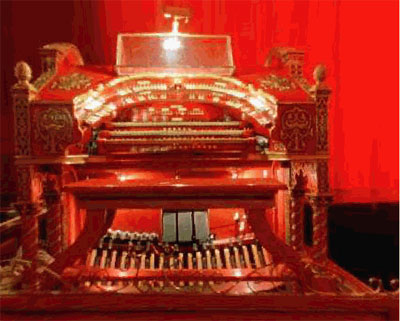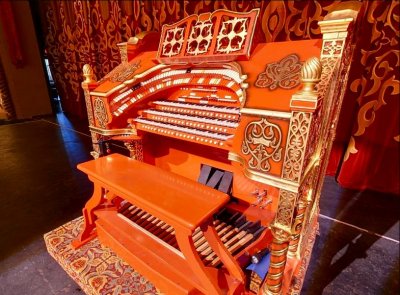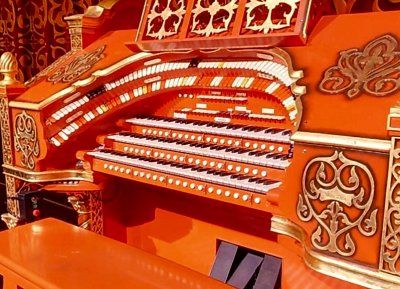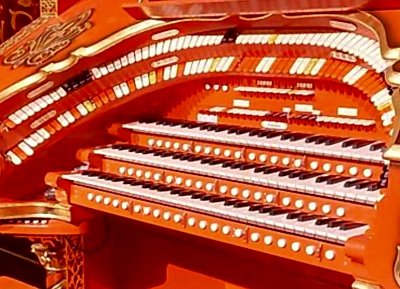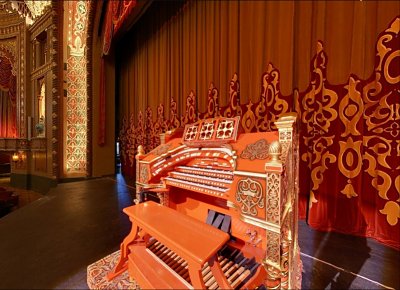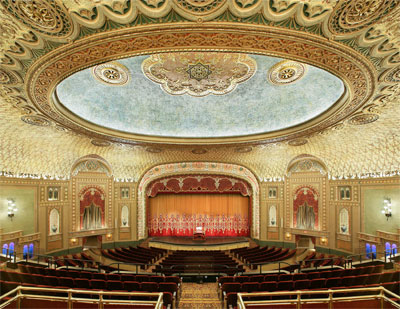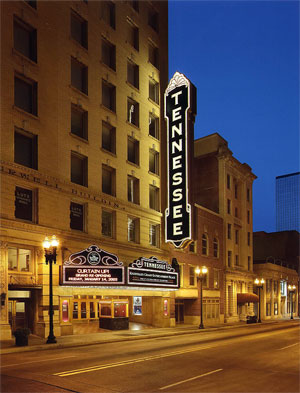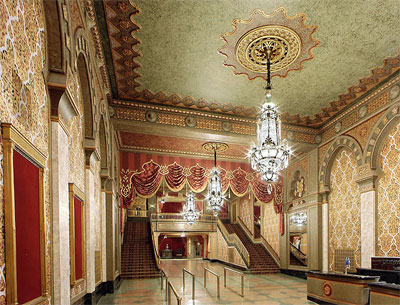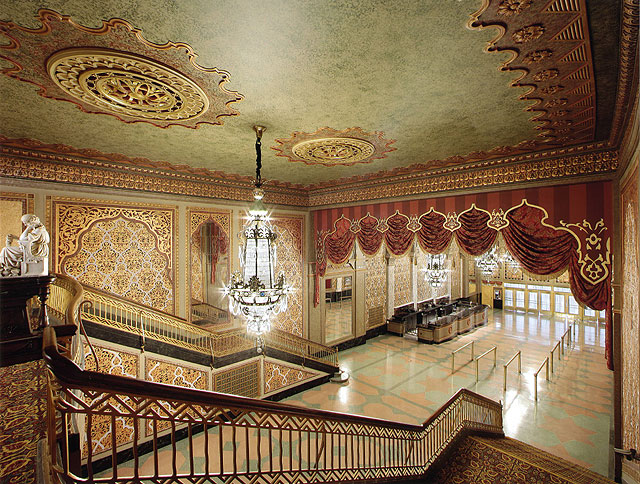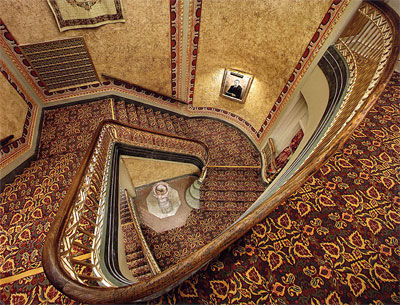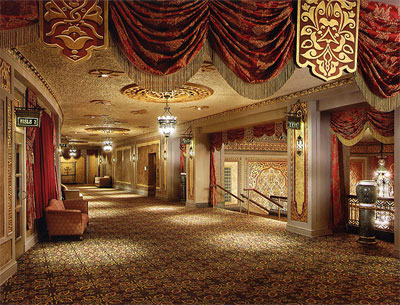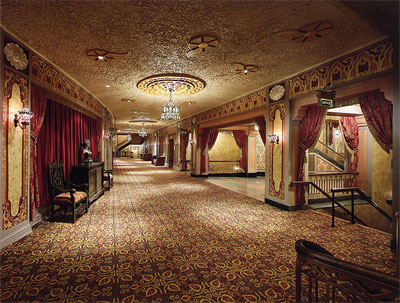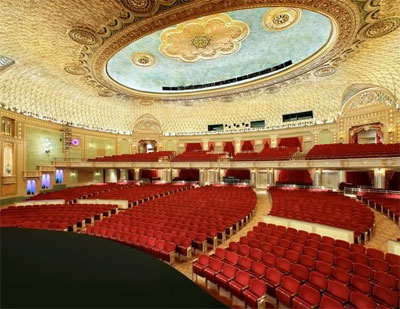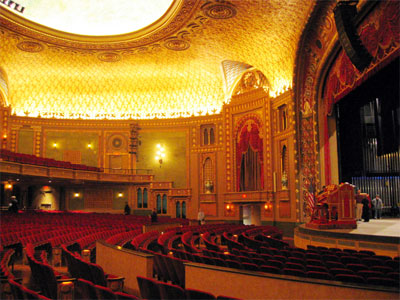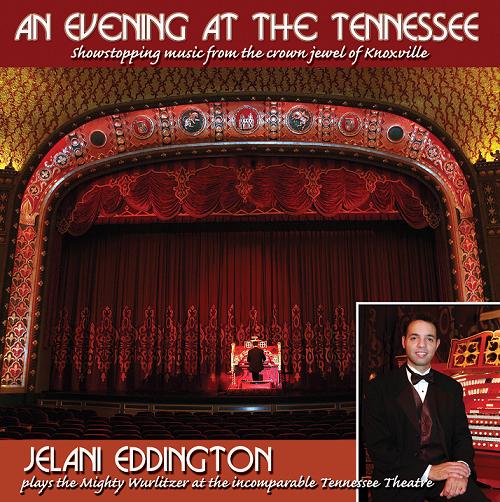
|
|
3/17 Mighty WurliTzer
|
|
The seventh organ to be featured here is the 3/17 WurliTzer Theatre Pipe Organ, installed at the Tennessee Theatre in Knoxville, Tennessee. It is lovingly referred to as " Princess Eleonore, the Jewel of the Great Smoky Mountains."
The console of this magnificent machine, an original Balaban 2 Style WurliTzer done in a French Moorish motif, is like only one other WurliTzer Theatre Pipe Organ with an original red console, and that is the 4/24 Mighty WurliTzer, installed at the Alabama Theatre in Birmingham, Alabama. The Tennessee instrument was one of only two such instruments ever made by WurliTzer.
The beautiful gold leafed console, along with the entire workings of the instrument, were rebuilt in 1998 by Ken Crome of Reno, Nevada. The instrument, which was installed in the theatre in 1928, is one of the few remaining original installations left in the United States. It was returned to the Theatre in 2001 to be inaugurated by the world famous organist, Lyn Larsen. The event drew a packed house.
This magnificent instrument came from the factory with 14 ranks, but Mr. Crome expanded these to 17 ranks during the rebuild, giving it a world class voice. A digital Uniflex relay replaced the elecromechanical relay, and full MIDI implimentation was added. There are 32' digital extentions in the Pedal and all nine footages (16', 8', 5-1/3', 4', 2-2/3', 2', 1-3/5', 1-1/3' and 1') are available in the Tibias. There is also a new Gottfreed 16' English Post Horn available in the Accompaniment, Great, Solo, Pedal and Second Touches. The organ has been highly unified.
The sound of the Tennessee Theatre 3/17 Mighty WurliTzer is wonderfully balanced within the auditorium of this grand movie palace. The instrument was voiced by Lyn Larsen, who has said that, "It is one of the finest installations in the country, one I am very excited about and glad to play." See the 3/17 Mighty WurliTzer page at the Tennessee Theatre website for more details.
The following information was taken directly from the official Tennessee Theatre website. Pipe RanksThe Tennessee Theatre 3/17 Mighty Wurlitzer Theatre Pipe Organ has 3 manuals, a 32-note pedal board, and 17 ranks of pipes. Below are the names of the ranks which this wonderful organ contains:
Special EffectsIn addition to pipe produced sounds, this instrument has a number of special effect and percussion sounds. These special effects were originally conceived for the accompaniment of silent movies, but they are useful in adding variety to the musical sounds produced by pipes.
The InstallationThe organ is entirely under expression with all pipes and sound producing features enclosed in two chambers, one on each side of the auditorium's highly ornate proscenium arch. The organ console was completely reconfigured as part of the total restoration of the organ. It was meticulously repainted the original red and gold colors that the instrument had when it left the WurliTzer factory in 1928. The console is on a lift that can move from stage level to orchestra pit level. The organist controls the movement of the lift, and can stop it at any position between full down and full up. It can also ride on a dolly to center stage. When the Mighty WurliTzer is not being played, the console is stored in a special climate controlled "garage" below stage level for safe keeping. Connection to the chambers is provided by four small LAN style cables. The console can be brought out and readied for a show in less than ten minutes. Although it weighs nearly a ton, two men can easily wheel it about in its entirity from garage to stage on the special platform dolly which is equipped with large lockable castors. The ActionOne of the most useful features of the organ from the player's perspective is the Uniflex electronic control of the organ registration and stops. The organist can set the pistons and toe studs at the console and make instantaneous changes in registration by pressing a piston or toe stud. These registrations and the performances thereon can be stored on the Uniflex computer for later recall. Also of note, the organ has complete MIDI implementation, including recording and playback of all data sent by the organist during a performance. There are 60 pistons that can be set by the organist at the console to bring on a certain combination of stops by pushing a button. When a piston or stud is pressed, the stops it is associated with move. These pistons are arranged under the manuals for easy access by the theatre organist. There are 20 pistons under each manual. In addition there are 7 toe studs that can be activated by the organist's left foot. There are three swell shoes in the console, one for the main chamber, one for the solo chamber, and another for crescendo. To the right of the swell shoes are four double touch programmable piano pedals.
When the theatre was designed and constructed, special attention was paid to the integration of the pipe organ with the auditorium. No expense was spared, and the wedding between the two was perfect. You could say that the auditorium was designed around the organ, as seen in the picture of the lavish auditorium above. The theatre first opened on October 1, 1928, and with nearly 2,000 seats in the auditorium, was billed as "Knoxville's Grand Entertainment Palace". Its interior was designed by Chicago architects Graven & Mayger in the Spanish-Moorish style, although the design incorporates elements from all parts of the world: Czechoslovakian crystals in the French-style chandeliers, Italian terrazzo flooring in the Grand Lobby, and Oriental influences in the carpet and drapery patterns. The theatre was one of the first public buildings in Knoxville to have air conditioning. The theatre also featured a beautiful WurliTzer Theatre Pipe Organ. During its heydey, the theatre played host to a few world movie premieres, including So This is Love (1953), and the adaption of James Agee's All the Way Home (1963). After a refurbishment in 1966, the theatre's seating capacity was lowered to 1,545. The theater changed owners several times over its life, and eventually closed for the first time in 1977, and then was open and closed intermittently for the remainder of the late 1970s. The theatre was purchased by local radio company Dick Broadcasting in 1981, who started a renovation effort to prepare it for the 1982 World's Fair. On April 1, 1982, the theatre was placed on the National Register of Historic Places. More recently, the theatre was the home for the Appalachian Ballet, the Knoxville Opera, and the Knoxville Symphony Orchestra. In 1999, the theatre, now owned by The Historic Tennessee Theatre Foundation, was designated "The Official State Theatre of Tennessee". In 2001, the Foundation announced a campaign to completely restore and renovate the Tennessee Theatre. The $25.5 million project was funded through public and private donations. The theater closed for renovations in June 2003 to completely restore it to its original glamour. Renovations included expansions of the stage depth and height to accommodate larger and more elaborate productions, an enlarged orchestra pit, upgraded dressing room facilities, modernization of the lighting, rigging, and other theatrical equipment, the installations of elevators, and a new marquee. The restorations included new carpets, draperies, and lighting fixtures that duplicated the original designs, and historically accurate restoration of all plaster and paint surfaces throughout the lobby, lounges, foyers, and the auditorium. The theatre reopened January 14, 2005 to a near sold-out season, and now offers a wide range of performing arts events and classic films to the public. It is managed by AC Entertainment. There is also a free WurliTzer Theatre Pipe Organ concert open to the public on the first Monday of every month, starting at noon.
Below are a few words from the Bone Doctor about Jelani Eddigton's CD entitled An Evening At The Tennessee. We quote him in blue text: Hi, Folks. Today the mailman delivered a package I have been champing at the bit to get. I brought it inside and opened it to find two copies of a CD I have been looking forward to listening to ever since I heard about it back when it was being produced. One was for me, and the other was for my wonderful friend, Fred Willis. Jelani Eddigton went to my home state of Tennessee and played the magnificent 3/17 Mighty WurliTzer Theatre Pipe Organ installed at the glorious Tennessee Theatre. He recorded an album of pure wonder entitled An Evening At The Tennessee, and he made that lovely red and gold Balaban 2, affectionately known to all who love her as Princess Elenoir, sound like the royalty which she is, indeed. I highly recommend this beautiful recording to all who not only love the sound of the King of Instruments, but who enjoy what it can do in the hands of a master, which Jelani surely is. My hat is off to him. Bravo! Well done, Laddie. Aye. To purchase your copy of this superb CD, click the URL below: http://www.rjeproductions.com/recordingsTEN.shtml You'll be glad you did. |
